There are things you can kill - a good story is certainly not one of them. Stories are immortal, particularly when they are captivating, insightful, and memorable.
When Plato said, "those who tell stories rule the world," he certainly wasn't thinking about marketing, but nowhere could that quote be even more real and emphatic.
Seth Godin couldn't have put it better: "marketing is no longer about the stuff that you make, but about the stories you tell." That is why case studies are crucial to the growth of every business.
A case study is content that details the success story of a product or service. Typically, it outlines the problems the client had and how the service or product of a business resolved them. In this article you’ll learn:
- Know why your business needs to invest in case studies
- Learn how to prepare a case study
- Learn how surveys can make your case more effective
- Different ways to use case studies for maximum impact
Featured Resource:
This guide shares a process for making compelling case studies to convert more prospects. To make the most out of it, we’ve prepared a case study template, checklist, and 13 examples you can use for inspiration.
Why should you invest in a case study?
Almost every business can improve its results by investing in case studies. Below are a few reasons case studies are invaluable for your business.
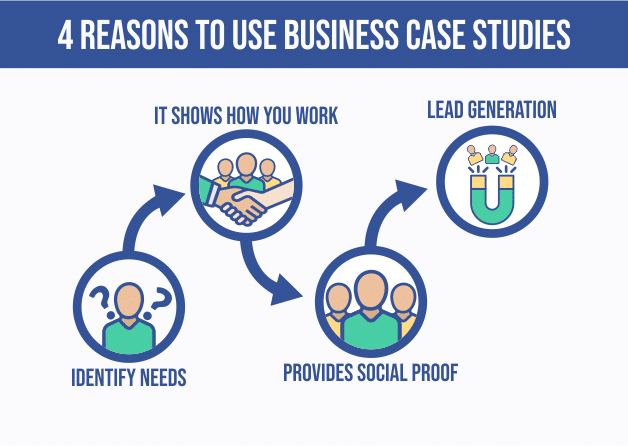
Shows prospective clients how you work
Sometimes, leads don’t realize they have a certain problem that your product or service can resolve. A case study can provide a clear overview of the value you bring to the table. This is particularly useful for business and marketing consultants, where the outcomes may not be as visible.
It establishes your authority
Case studies are particularly effective for companies offering a product or service focused on a certain niche. They show how a company like theirs benefitted from your service. Ninja Outreach is a good example of this.
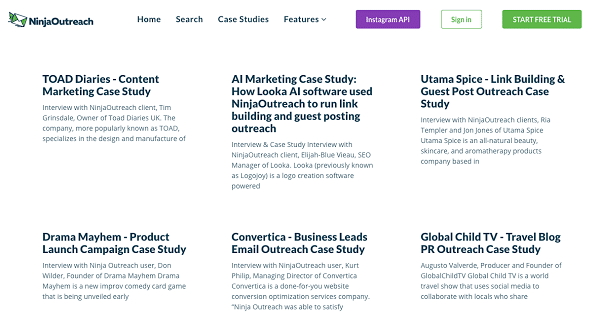
It has gathered case studies that focus on the problems of their various customer personas. This ranges from a firm running a PR campaign to an eCommerce store doing email outreach to land guest post placements. Each case study is designed to resonate with a specific customer persona to help them see the value of the product.
It Shows Prospective Clients How you Work
A good case study illustrates how you work and approach a problem. For example, if one of your unique selling points is excellent customer service, a case study can highlight this through the words of an existing client.
A good case study can also help set expectations. For example, your case study might explain how you start every project with a two week review period. Or your company works in sprints. Again, it clarifies what a customer should expect when working with you.
It’s an Excellent Lead Generation Tool
When you’ve dialed in your messaging, you’re attracting the right type of visitor and they believe your service is right for them. The only thing left is proof of results and a case study can serve that purpose. When you use it for lead generation and require prospects to download it, you know they’re qualified and can follow up with them confidently.
People researching a company often look for social endorsements before making a purchase or investing in a service. It is part of the customer journey. Social proof, like that offered in the form of a case study, can help convert a warm lead into a customer.
How to Prepare Your Case Study
We’ve covered some of the reasons why a case study can be such an essential element of your business development strategy. Now, let’s focus on how to create a case study that engages and converts a lead and plays a role in turning them into a customer.
Start with a Clear Objective
Ultimately, the objective of your case study is the same; to help turn a warm lead into a paying customer. To do that with case studies, you should understand who you’re targeting.
A customer persona will make this easier. It should reflect the different types of people or companies that seek your service and your case studies should be created to appeal to them.
Find the right candidate for your case study
If you have delivered value, finding clients for case studies should be easy. A case study doesn’t only benefit you; the client being featured receives several benefits including backlinks and exposure of their brand.
You don’t always have to wait until the end of the contract to ask a client to be your case study. You can ask for a case study as soon as you deliver a solution that works. However, this should be determined on a case-by-case basis.
Select Medium(s)
While most people are familiar with written case studies, there are many other ways to share your message. These days podcasts shows, platforms like Pinterest, and video channels have a huge say in marketing. Choose as many mediums as you can so you’re creating content the way your visitor wants to consume it.
Though this article is mainly for people who are writing a case study, it can be used during the research process for a video testimonial.
Why Use Surveys When Creating a Case Study?
The effectiveness of a case study is based on the insights you get from the client. While you probably have the outcomes clearly defined before you start the process, the little details make your content engaging.
When preparing a case study, you should collect two types of data; quantitative and qualitative. Quantitative data refers to that which can be measured. This covers things like profit, traffic to the website, leads, conversions, etc.
Qualitative data refers to opinions and sentiments about a product or service. Essentially, it’s about what the client has to say about your product or service.

Questionnaires help you extract accurate quantitative and qualitative information. This will put you in the best position to create case studies that are valuable resources for your business.
What Questions Should You Ask in a Survey?
The questions in a case study survey should revolve around the following:
- The challenge or problem the client was facing
- How the challenge was addressed
- The benefits the client experienced or is experiencing
You should ask a mixture of closed (yes or no questions) as well as open-ended questions. Your questions should be simple and straight to the point. Some simple questions you can ask include:
- How was the problem you faced affecting your business?
- If you didn’t find our solution, where would you be now?
- Did you seek other solutions? Were they any help?
- Why did you choose us over our competitors?
- What was your most memorable moment working with us?
- How has our solution transformed your business?
Don’t overburden the client with a truckload of questions: 20 questions or less should suffice.
Your survey will help you prepare for a follow-up interview where you can ask clarifying questions based on the information you received. Read more about choosing the right type of surveys in this article.
The importance of storytelling
Let’s dig deeper into the importance of storytelling. Dr. Howard Gardner, a professor at Harvard University aptly remarked: “Stories constitute the single most powerful weapon in a leader’s arsenal.”
Data, insights, and statistics from surveys and interviews are critical, but an engaging study will have its roots in a story. Rob Walker and Joshua Glenn put the power of stories to the test by purchasing various “insignificant” objects each for $1.25 on average.
They engaged about 200 writers to help put a narrative to the objects on eBay. Each item had a heartfelt short story written underneath. Guess what? The items, on average, sold for 2,700% above their original price.
People make emotional decisions regarding purchases, and that is why stories can ramp the value of your products. Our brains are hardwired for stories. Here are simple ways to inject storytelling in your case study.
- Make your client the hero: Everybody loves heroes. Imagine Superman was killed right at the beginning of the movie. There would undoubtedly be a money-back hashtag immediately trending.
- Let the client tell the story: Focus on the client’s story because yours naturally supports it.
- Write in an engaging way: Don’t write in a boring, dry, and monotonous style. Give life to your content by writing in a conversational tone. If you can’t then hire someone from one of the popular freelancing websites who is well-versed in case studies.
- Give evidence: That’s the name of the game: evidence. Then, back up your client’s claims with screenshots, pictures, infographics, etc.
4 Ways to use a case study in your sales funnel
Sales funnels are crucial to the bottom line. With a well-laid-out sales funnel, businesses can plan, strategize, and optimize their customer’s buying journey. Here’s a general idea of what a sales funnel looks like.
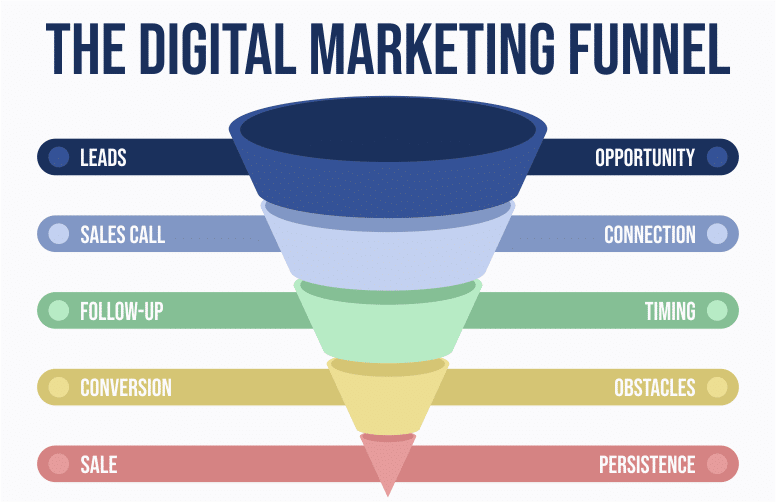
Here are some ways to integrate case studies into your sales funnel.
Make it accessible on your website
Case studies should be readily accessible on your website because they help your visitor learn more about your company and move down the sales funnel.
Make your case studies, particularly recent ones, prominent on your website. Consider placing it on your home page or within your main navigation. Many companies have a dedicated case study page or section on their site like this:
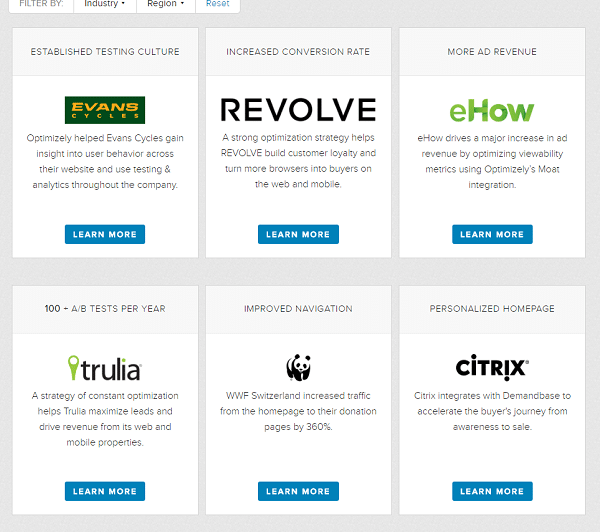
Source: crazyegg.com
Take out some quotes from your case studies, or use a quote generator to highlight key insights. Have your designers add a creative touch to it and feature these on your website, along with links to the full case studies. You can also link to your case studies from landing pages.
Incorporate Your Case Study in an Email Marketing Campaign
When a person signs up to your email list, they are open to learning more about your company. You can use your email marketing software to introduce the prospect to your brand, familiarize them with your service, and generate revenue.
It is natural to incorporate case studies within your email campaigns. Particularly so if you are an agency selling a service.
The case study forms a natural reference point as the prospect learns about your company and the products and services you offer. Check out this insightful article on email marketing to learn more about the topic.
Use it for Cold Email Outreach
Cold emails are a powerful sales approach for generating leads and getting conversions. Businesses often cold pitch to leads that have little knowledge of the company approaching them.
A case study attached to a professional email, as a PDF, is a logical way to introduce them to the service you deliver. Alternatively, you could insert extracts from a case study into the email you are sending to a lead.
Here’s an example:
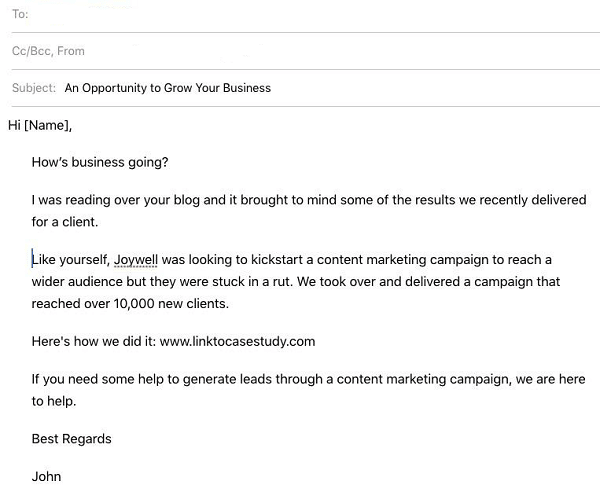
Use your case study in your sales meetings
Researching, writing, and creating a case study is a time-consuming process. However, through this process, you learn a lot about the pain points your customers faced and the benefits they accrued.
All of this information is useful when pitching to a prospect. You can draw on this knowledge to better align the product or service you are providing with the problems a lead faces. This ability to empathize can help you make a sale. It’s particularly important in B2B sales because there’s a lot of money on the line. You can incorporate case studies into your business proposal and use them to illustrate your process and the value you bring to the table.
Of course, a case study is a useful prop for a sales meeting. Provided in the form of a brochure, they give people something to leaf through after a meeting. You can also use it in a meeting when making a point.
Conclusion
According to Global Trust in Advertising and Brand Messages, a report by Nielsen, online consumer reviews are the second most trusted source of brand recommendation. Case studies are, in essence, strong peer recommendations.
This lends credence to your business. People are more likely to believe claims from consumers like them, who share their problems.
When fleshed out, the best case studies are based on the information you glean from clients. That is where surveys are crucial. Use the points listed above to give your case studies an X-factor that’ll help you drum up more revenue.
Owen Baker is a content marketer for Voila Norbert, an online email verification tool. He’s spent over a decade in online marketing. He enjoys sharing his knowledge of content marketing across a range of websites.